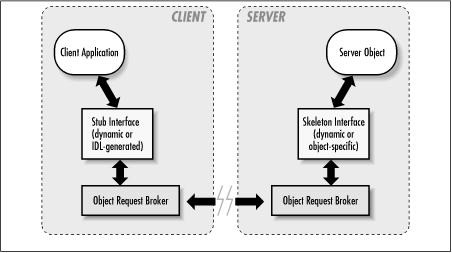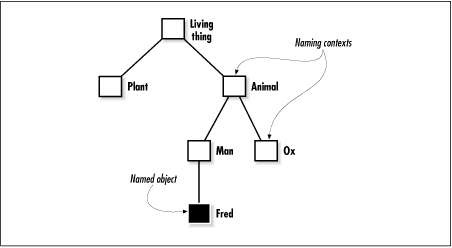
Chapter 4. Java IDL
Contents:
The CORBA Architecture
Creating CORBA Objects
Putting It in the Public Eye
Finding Remote Objects
What If I Don't Know the Interface?
The Java IDL API, introduced in Version 1.2 of the Java 2 platform, provides an interface between Java programs and distributed objects and services built using the Common Object Request Broker Architecture (CORBA). CORBA is a standard defined by the Object Management Group (OMG). It describes an architecture, interfaces, and protocols that distributed objects can use to interact with each other. Part of the CORBA standard is the Interface Definition Language (IDL), which is an implementation-independent language for describing the interfaces of remote-capable objects. There are standard mappings defined by the OMG for converting IDL interfaces into C++ classes, C code, and Java classes, among other things. These generated classes use the underlying CORBA framework to communicate with remote clients and give you the basis for implementing and exporting your own distributed objects. Java IDL is an implementation of the standard IDL-to-Java mapping and is provided by Sun with the standard Java SDK in the org.omg.CORBA and org.omg.CosNaming packages and their subpackages.[1]
[1]The version of Java IDL shipped with Version 1.2 of Java 2 is compliant with the CORBA 2.x specification.
Like RMI, Java IDL gives you a way to access remote objects over the network. It also provides the tools you need to make your objects accessible to other CORBA clients. If you export a Java class using Java IDL, you can create an instance of that class and publish it through a naming/directory service. A remote client can find this object, call methods on it, and receive data from it, just as if it were running on the client's local machine. Unlike RMI, however, objects that are exported using CORBA can be accessed by clients implemented in any language with an IDL binding (C, C++, Ada, etc.).
The CORBA standard is extensive, to say the least. In addition to the basic remote object architecture and the syntax of IDL, it also includes specifications for several distributed object services, like an object naming service, a security policy service, and persistent object services. It would be foolhardy to attempt to cover all these topics completely in one chapter, so I won't. Instead, I'll just cover the basic features of the CORBA architecture and the IDL syntax. We'll also look at the Naming Service, which is key to almost every CORBA application because it provides a standard way to find remote CORBA objects on the network. With that under our belts, we'll take a look at the Java IDL API and the idltojava compiler and how together they give you an interface from your Java code to CORBA objects and services. They also give you the tools you need to create your own CORBA objects, implemented in Java.
The rest of this chapter is broken down roughly into three parts. In the first part, we'll look at an overview of the CORBA architecture and how it allows you to create, export, access, and manage remote objects. In the second part, we'll explore the details of creating your own CORBA objects. Finally, we'll look at how clients can remotely access your CORBA objects.
4.1. The CORBA Architecture
At its core, the CORBA architecture for distributed objects shares many features with the architecture used by Java RMI. A description of a remote object is used to generate a client stub interface and a server skeleton interface for the object. A client application invokes methods on a remote object using the client stub. The method request is transmitted through the underlying infrastructure to the remote host, where the server skeleton for the object is asked to invoke the method on the object itself. Any data resulting from the method call (return values, exceptions) is transmitted back to the client by the communication infrastructure.
But that's where the similarities between CORBA and RMI end. CORBA was designed from the start to be a language-independent distributed object standard, so it is much more extensive and detailed in its specification than RMI is (or needs to be). For the most part, these extra details are required in CORBA because it needs to support languages that have different built-in features. Some languages, like C++, directly support objects, while others, like C, don't. The CORBA standard needs to include a detailed specification of an object model so that nonobject-oriented languages can take advantage of CORBA. Java includes built-in support for communicating object interfaces and examining them abstractly (using Java bytecodes and the Java Reflection API). Many other languages do not. So the CORBA specification includes details about a Dynamic Invocation Interface and a Dynamic Skeleton Interface, which can be implemented in languages that don't have their own facilities for these operations. In languages that do have these capabilities, like Java, there needs to be a mapping between the built-in features and the features as defined by the CORBA specification.
The rest of this section provides an overview of the major components that make up the CORBA architecture: the Interface Definition Language, which is how CORBA interfaces are defined; the Object Request Broker (ORB), which is responsible for handling all interactions between remote objects and the applications that use them; the Naming Service, a standard service in CORBA that lets remote clients find remote objects on the network; and the inter-ORB communication that handles the low-level communication between processes in a CORBA context.
4.1.1. Interface Definition Language
The Interface Definition Language provides the primary way of describing data types in CORBA. IDL is independent of any particular programming language. Mappings, or bindings, from IDL to specific programming languages are defined and standardized as part of the CORBA specification. At the time of this writing, standard bindings for C, C++, Smalltalk, Ada, COBOL, and Java have been approved by the OMG. Chapter 10, "IDL Reference", contains a complete description of IDL syntax.
The central CORBA functions, services, and facilities, such as the ORB and the Naming Service, are also specified in IDL. This means that a particular language binding also provides the bindings for the core CORBA functions to that language. Sun's Java IDL API follows the Java IDL mapping defined by the OMG. This allows you to run your CORBA-based Java code in any compliant Java implementation of the CORBA standard, provided you stick to standard elements of the Java binding. Note, however, that Sun's implementation includes some nonstandard elements; they are highlighted in this chapter where appropriate.
4.1.2. Object Request Broker
The core of the CORBA architecture is the Object Request Broker, as shown in Figure 4-1. Each machine involved in a CORBA application must have an ORB running in order for processes on that machine to interact with CORBA objects running in remote processes. Object clients and servers make requests through their ORBs; the ORB is responsible for making the requests happen or indicating why they cannot. The client ORB provides a stub for a remote object. Requests made on the stub are transferred from the client's ORB to the ORB servicing the implementation of the target object. The request is passed onto the implementation through its skeleton interface.

Figure 4-1. Basic CORBA architecture
4.1.3. The Naming Service
The CORBA Naming Service provides a directory naming structure for remote objects. The tree always starts with a root node, and subnodes of the object tree can be defined. Actual objects are stored by name at the leaves of the tree. Figure 4-2 depicts an example set of objects[2] registered within a Naming Service directory. The fully qualified name of an object in the directory is the ordered list of all of its parent nodes, starting from the root node and including the leaf name of the object itself. So, the full name of the object labeled "Fred" is "living thing," "animal," "man," "Fred," in that order.
[2]Example adapted from Categories, by Aristotle. Please pardon the categorization "man," as opposed to "human." This is the typical translation of Aristotle's original Greek, perhaps because political correctness wasn't in fashion in 350 B.C.

Figure 4-2. A naming directory
Each branch in the directory tree is called a naming context, and leaf objects have bindings to specific names. The org.omg.CosNaming.NamingContext interface represents each branch in the naming directory. Each NamingContext can be asked to find an object within its branch of the tree by giving its name relative to that naming context. You can get a reference to the root context of the naming directory from an ORB using the resolve_initial_references() method. The standard name for the Naming Service is "NameService", so the following code snippet gets the root NamingContext:
ORB myORB = ORB.init(...);
org.omg.CORBA.Object nameRef =
myORB.resolve_initial_references("NameService");
NamingContext nc = NamingContextHelper.narrow(nameRef);
Note that we have to narrow the Object reference to a NamingContext reference using the NamingContextHelper.narrow() method. Even though Java has a cast operation in its syntax, there's no guarantee in the Java IDL binding that the object reference returned by the resolve_initial_references() method is the correct type, since there's no guarantee that the local environment has access to the language-specific definition of the object's interface.
This narrow() operation highlights one of the key differences between RMI and CORBA. In the Java environment, class bytecodes are portable, and all remote object types are objects that can be specified by their full class names. An RMI client can automatically download the bytecodes for a remote stub from the object server, if the class for the stub cannot be found locally (see Chapter 3, Remote Method Invocation, for more details on the mechanics of remote class loading). CORBA is a language-independent remote object scheme, so there is no portable way to specify a remote object's type when a client obtains a stub reference. As a result, the stub reference is initially represented by a basic ObjectImpl object that knows how to forward methods requests to its server object. The client application is forced to "cast" this stub to the correct local type, using the appropriate narrow() method. In the Java mapping of IDL, this means calling the narrow() method on the corresponding helper class. The narrow() method converts the reference, making a type-specific stub interface that also includes the remote object reference information needed to forward method requests to the actual object implementation.
4.1.4. Inter-ORB Communication
Version 2.0 (and later) of the CORBA standard includes specifications for inter-ORB communication protocols that can transmit object requests between various ORBs running on the network. The protocols are independent of the particular ORB implementations running at either end of the communication link. An ORB implemented in Java can talk to another ORB implemented in C, as long as they're both compliant with the CORBA standard and use a standard communication protocol. The inter-ORB protocol is responsible for delivering messages between two cooperating ORBs. These messages might be method requests, return types, error messages, etc. The inter-ORB protocol also deals with differences between the two ORB implementations, like machine-level byte ordering and alignment. As a CORBA application developer, you shouldn't have to deal directly with the low-level communication protocol between ORBs. If you want two ORBs to talk to each other, you just need to be sure that they both speak a common, standard inter-ORB protocol.
The Internet Inter-ORB Protocol (IIOP) is an inter-ORB protocol based on TCP/IP. TCP/IP is by far the most commonly used network protocol on the Internet, so IIOP is the most commonly used CORBA communication protocol. There are other standard CORBA protocols defined for other network environments, however. The DCE Common Inter-ORB Protocol (DCE-CIOP), for example, allows ORBs to communicate on top of DCE-RPC.

Copyright © 2001 O'Reilly & Associates. All rights reserved.



